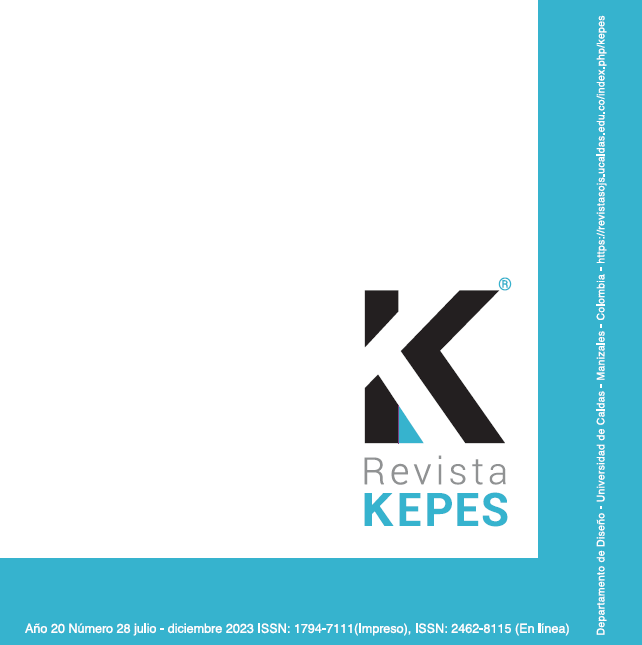Authors
Abstract
This article addresses fashion as a language that contributes to the construction of what it means to be a man in two Colombian films from the 1920s: Bajo el cielo antioqueño (1925) and Alma provinciana (1926). They are melodramatic films that narrate the ups and downs of lovers as they try to consolidate their love. They also project values, experiences, productive activities, the incipient process of modernization, class differences, social practices, consumption and fashion. Through a qualitative approach of film text analysis, the objective is to study the construction of masculinities expressed in the attributes of the characters and in the language of their costumes, exploring the different manifestations of what it was considered to be a man in Colombia during the 1920s. As a result of this research, a reflection on the existence of different types of masculinities (hegemonic, complicit and marginal) is established, in which the hierarchical and power relationships with women and men were taken into account. In addition, this work makes it possible to establish that the attributes of manhood, authority, violence, work, the role of provider in the family, courtship, the clothing used and the leading role of men in different spheres, public and private, constitute the characteristics that define the different types of masculinities. It is concluded that clothing became a marker of men's identity.
Keywords
References
Álvarez, L. A. (1989). Historia del cine colombiano. En A. Tirado Mejía (Ed.), Nueva historia de Colombia - Tomo IV (pp. 237-268). Planeta.
Barry, B. (2018). (Re)Fashioning Masculinity: Social Identity and Context in Men’s Hybrid Masculinities through Dress. Gender & Society, 32(11), 1-25. https://www.researchgate.net/publication/325468477_ReFashioning_Masculinity_Social_Identity_and_Context_in_Men’s_Hybrid_Masculinities_through_Dress
Biblioteca Nacional de Colombia - Hemeroteca Digital. (s.f.). La Prensa, Barranquilla, 29 de octubre de 1928, p. 9a. https://catalogoenlinea.bibliotecanacional.gov.co/client/es_ES/search/asset/192356
Bordwell, D. y Thompson, K. (1995). El arte cinematográfico: una introducción. Paidós.
Carlos, M. (2016). Moda y cine: signos y simbolismos. Cuaderno 58 / Centro de Estudios en Diseño y Comunicación, 17-22. https://dspace.palermo.edu/ojs/index.php/cdc/article/view/1238/1072
Chaverra, Y. A. (2011). El melodrama cinematográfico de los años veinte en Colombia: un cine hecho a imagen y semejanza del “pueblo” (tesis de maestría). Universidad de los Andes, Bogotá, Colombia. https://repositorio.uniandes.edu.co/bitstream/handle/1992/11577/u608416.pdf?sequence=1&isAllowed=y
Connell, R. W. (2003). Masculinidades. Universidad Nacional Autónoma de México.
El Tiempo. (8 de enero de 1925). El Tiempo, Bogotá, pp. 4ª y 7ª. https://news.google.com/newspapers?nid=N2osnxbUuuUC&dat=19250108&printsec=frontpage&hl=es
Fernández, M. (2000). Pobres, borrachos, violentos y libres: notas para la reconstrucción de identidades masculinas populares del siglo XIX. En J. Olavarría y R. Parrini (Eds.), Masculinidad/es. Identidad, sexualidad y familia. Primer Encuentro de Estudios de Masculinidad (pp. 47-58). Flacso.
Fogg, M. (2014). Moda. Toda la historia. Blume. García, L. B. (2017). Moda masculina y distinción social. El ejemplo de Asturias desde la Restauración hasta la Segunda República. Vínculos de Historia, 6, 153-170. http://vinculosdehistoria.com/index.php/vinculos/article/view/vdh.v0i6.273/pdf
Gómez, M. M. (2017). Hombre, masculinidad y crisis de la masculinidad en la Revista Cromos 1950-1970 (tesis de maestría). Universidad Eafit, Medellín, Colombia. https://repository.eafit.edu.co/bitstream/handle/10784/12936/MarilynMildred_GomezArango_2018.pdf;jsessionid=DAE5A7960180A774EA4B563A8FCC1416?sequence=2
León, M. (1995). La familia nuclear: Origen de las identidades hegemónicas femenina y masculina. En L. G. Arango, M. León y M. Viveros (Eds.), Género e identidad: ensayos sobre lo femenino y lo masculino (pp. 169-191). Universidad Nacional de Colombia, Tercer mundo, Uniandes.
Lurie, A. (1994). El lenguaje de la moda. Una interpretación de las formas de vestir. Ediciones Paidós.
Martínez, A. (1995). La prisión del vestido. Aspectos sociales del traje en América. Planeta Colombiana Editorial.
Moreyra, C. (2014). La ropa, lo masculino y lo civilizado. La vestimenta de los hombres en Córdoba (Argentina), siglo XIX. Temas Americanistas, 33, 84-108. http://institucional.us.es/tamericanistas/uploads/TA-33/ART%C3%8DCULO%20DEFINITIVO%20Moreyra.pdf
Niño, A. Y. (2016). Representaciones de la masculinidad en la Revista Cromos en la primera mitad del siglo XX en Colombia. Cuestiones de género: de la igualdad y la diferencia, 11,227-246. http://revpubli.unileon.es/ojs/index.php/cuestionesdegenero/article/view/1777
Ocampo, J. A. (2013). Colombia y la economía mundial 1830-1910. Ediciones Uniandes.
Pérez, A. (2011). Moda y trabajo: la expresión sociocultural de un “saber hacer”. Nueva antropología, 24(75), 43-70.
Rodríguez, F. J. (1926). Alma provinciana [Película]. Félix Mark Films.
Veneziani, M. (2016). Moda y cine: entre el relato y el ropaje. Cuaderno 58 / Centro de Estudios en Diseño y Comunicación, 87-98. https://dspace.palermo.edu/ojs/index.php/cdc/article/view/1252/1084
Yang, Y. (2020). What’s Hegemonic about Hegemonic Masculinity? Legitimation and Beyond. Sociological Theory, 38(4), 318-333. https://www.asanet.org/sites/default/files/attach/journals/dec20stfeature.pdf

 PDF (Español)
PDF (Español)
 FLIP
FLIP






















